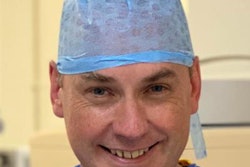
I'm writing this sitting at a MacBook Pro, using Pages. The screen is simple and uncluttered, the buttons on the right are clear, and they do exactly what I expect of them. How I cut, paste, copy, drag, highlight, or format my text is obvious and similar across most of the software. The only impediment to my writing, then, is the failure of my imagination. The process of getting my thoughts -- when they appear -- out and onto the page is almost effortless. A few keystrokes and there they are!
The human interface of modern well-designed software is invisible, presenting no cognitive barrier to the user so that they can focus their entire attention on the task at hand. This does not mean there is no learning curve, but learning the software is mostly also simple, even playful.
 Dr. Chris Hammond from Leeds, U.K.
Dr. Chris Hammond from Leeds, U.K.Someone who has never seen an iPad before can pick it up and use it in minutes. The wafer-thin instruction manual is redundant. There is no need for an online learning session: Playing with the device is enough; the software guides and teaches you.
Of course, this does not happen by accident. Modern software is the product of trial and error, human factors in design, ergonomics, and psychology: thousands of hours of development and many, many iterations of the program, each building on the last (remember WordPerfect?). The key to success in this development is a focus entirely on the user. On what they will need, rather than what the system architecture might favor. Steve Jobs, co-founder of Apple Inc., famously insisted on rounded corners to buttons and had his team work tirelessly until the impossible was achieved.
Which brings me to PACS.
As radiologists, we spend nearly all our working hours in darkened rooms looking at computers running PACS software: These systems, huge databases storing terabytes of information, are a miracle of information management. Given the complexities of managing a database that is constantly being added to, queried, indexed, and manipulated by hundreds of simultaneous users and medical image generation devices, 24 hours a day, 365 days a year, it's astonishing they don't fail more often.
Modern healthcare could not function without readily available medical imaging, and this would not be possible without PACS. These systems are a quiet revolution that has occurred within my working career; everyone who was a junior doctor in the mid and late 1990s will remember wasted hours searching dusty libraries for moth-eared buff packets containing an almost certainly incomplete set of that patient's filmed imaging.
So why then do I hate almost every single PACS I've worked with?
Maybe part of the answer lies in forgetting how bad it was before digital systems. I just about remember reporting plain radiographs from film, but the only time I saw filmed CT images as a radiology trainee was in my viva for the Fellowship of the Royal College of Radiologists (FRCR) qualification. I do remember the on-call system being so slow that scrolling through an image stack was impossible and a system crash was sufficiently frequent that I ended up making paper notes for a while. Compared with that, modern systems are amazing.
Cluttered interface
I think the main issue for PACS is the ergonomics of the interface, which, unlike the software on my laptop, is frequently cluttered and busy, sometimes confusing, and (most aggravatingly) not intuitively interactive.
Relevant information is lost in a sea of metadata. Things that should take one click of a mouse take several. Drag and drop works in some places and not others. Normal workflow requires cumbersome workarounds. Navigating the software creates an additional cognitive burden which over the course of a reporting session can become exhausting, even if it does not actually slow down my already sedate reporting pace.
I am not convinced that this comes entirely down to money and the vast experience of international technology companies to tweak their products. Many small software developers are able to produce simple effective interfaces, even on small devices, as evidenced by what is available on App Stores.
It feels to me like the focus during development of the systems I have experienced has paid insufficient attention to the ergonomics and configurability of the interface and on how a user will interact with the impressive underlying system architecture. Reporting environment and workflow preferences will vary from person to person but the tools to facilitate his are not new. Even Windows Vista had a "Setup Wizard."
Perhaps I am being overly picky, spoiled by the quality of the 'front end' of modern mass-market software. After all, a PACS workstation is orders of magnitude more complex than a word processor, right? There is bound to be a learning curve and maybe it's not reasonable to expect to just pick it up?
I think this is arguable when you compare PACS with complex software like Photoshop or FinalCut Pro. But when software is complex, it's all the more important to allow guided play with it to learn. And to play, the software needs either to be fun (maybe this is too much to ask for a Friday afternoon reporting session) or at least intuitive and in line with other software behaviors. Learning when frustrated is almost impossible. Software training only gets you so far. I find taught click sequences almost impossible to recall.
Does any of this matter?
Does it matter that I find using PACS frustrating (and informal conversations suggest it's not just me)?
This comes down to where we started. If the software is invisible, I can give my entire attention to what I am trained to do. Starting an interventional case exasperated after battling to get the patient prepared and into the department means a mistake is more likely. So too wrestling with PACS to get it to do what I want surely increases reporting error and ultimately will affect morale, enthusiasm, and throughput.
Human factors are as important in software design as they are in the development of a safe cockpit for an aircraft. Ignore them and eventually, a system will fail. I don't need rounded corners on my buttons, but if this is a by-product of a relentless focus on the user experience, I'll take them.
Dr. Chris Hammond is a consultant vascular radiologist and clinical lead for interventional radiology at Leeds Teaching Hospitals NHS Trust, Leeds, U.K.
The comments and observations expressed herein do not necessarily reflect the opinions of AuntMinnieEurope.com, nor should they be construed as an endorsement or admonishment of any particular vendor, analyst, industry consultant, or consulting group.




















